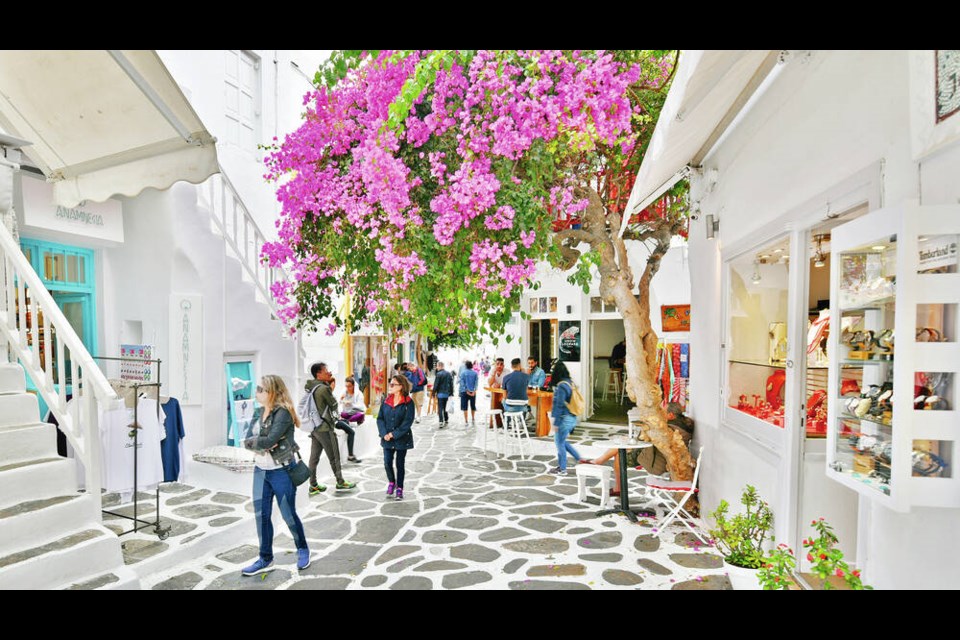I’ll never forget the moments after I’d jumped ship in Mykonos: While enjoying a glass of ouzo in a tiny taverna, I watched my mighty cruise ship sail away and take with it the 3,000 tourists who had inundated the charming port just an hour before. Having pushed their postcard racks back indoors, it seemed the shopkeepers were satisfied that they’d made their money for the day, and suddenly a sleepy charm blanketed both the locals and the visitors who remained on perhaps the most famed island in the Aegean Sea.
Mykonos is the classic Greek-island stop and, along with Santorini, it’s the most touristy. But being on Mykonos that day reminded me how enduringly charming the Greek islands are — if you can avoid those crowds.
Mykonos’s port, Chora (more often referred to as “Mykonos town”), is a humble seafront village crouched behind a sandy harbour, thickly layered with blinding-white stucco, bright-blue trim, and bursting-purple bougainvilleas. Thank goodness for all that colour, since otherwise this island — one of Greece’s driest — would be various shades of dull-brown. On a ridge over town stretches a trademark row of six windmills, overlooking a tidy embankment so pretty they call it “Little Venice.”
The sea, the wind, the birds, and the weather-beaten little whitewashed churches all combine to give the town a vibrant allure. Everyone gathers in the cafés and pubs to nurse an ouzo or other drink, and to watch the sun set to the rhythm of the sloppy, slamming waves.
While Mykonos town has some museums, they merely provide an excuse to get out of the sun for a few minutes. The real attraction here is poking around the streets: shopping, dining, clubbing, or — best of all — simply strolling. The core of the town is literally a maze, designed by the Mykonians centuries ago to discourage would-be invaders from finding their way. That tactic also works on today’s tourists. But I can think of few places where getting lost is so enjoyable.
When you’re done exploring the town, it’s time to relax at one of the enticing sandy beaches around the island. Each beach seems to specialize in a different niche: family-friendly or party; straight, gay, or mixed; nude or clothed; and so on. (Keep in mind that in Greece, even “family-friendly” beaches have topless sunbathers.)
The low-key beach in Ornos, ideal if you brought your kids, is easy to reach and has an unpretentious charm. Or you might try Psarou and Platis Gialos — two beaches along a cove to the east of Ornos. Psarou is considered a somewhat exclusive, favourite retreat of celebrities, while Platis Gialos feels more geared toward families (and is therefore more crowded). And Paradise is Mykonos’s famous “meat-market” beach, a magnet for partiers in the Aegean. Located at the southern tip of the island, Paradise (a.k.a. Kalamopodi) is presided over by hotels that run party-oriented bars for young beachgoers.
My favourite beach is Agios Ioannis, a remote patch of sand tucked behind a mountain ridge that gives me the feeling of being on a castaway isle. Two restaurants share this sandy, idyllic Robinson Crusoe spot between Ornos and Kapari.
All these beaches have comfortable lounge chairs with umbrellas out on the sand. Just take a seat — someone will eventually come by to collect money. Be warned that in peak season — July and August — it can be difficult to find an available seat.
From Mykonos town, you can take a public bus to any of these beaches, or you can ride a boat to Paradise, then beach-hop on the shuttle boat that connects Paradise, Super Paradise, Platis Gialos, and Paraga beaches. Another alternative is to rent a car, motor scooter, or all-terrain vehicle (ATV). If I wanted to drive a scooter or ATV on a Greek isle, I’d do it here, where the roads are not too heavily trafficked (you’ll pass more fellow scooters and ATVs than cars), and idyllic beaches are a short ride away.
Popular as Mykonos is today, it was just another island centuries ago, and the main attraction was next door: the island of Delos. According to Greek myth, this was the birthplace of the twin deities Apollo (god of the sun) and Artemis (goddess of the moon).
Today Delos is reachable only by a 30-minute boat trip from Mykonos; it has no residents — only ruins and a humble museum. If you go, you’ll see the much-photographed Lions of the Naxians — a row of five sphinx-like lion statues — some nice floor mosaics, and a windswept setting pockmarked with foundations.
Delos was a pilgrimage site for believers who came from all over to worship this “birthplace of light.” Judging by the present-day sun-worshippers who scramble for the best patch of sand on Mykonos each summer, things haven’t changed much around here.
This article is used with the permission of Rick Steves’ Europe. Rick Steves writes European guidebooks, hosts travel shows on public TV and radio, and organizes European tours.



